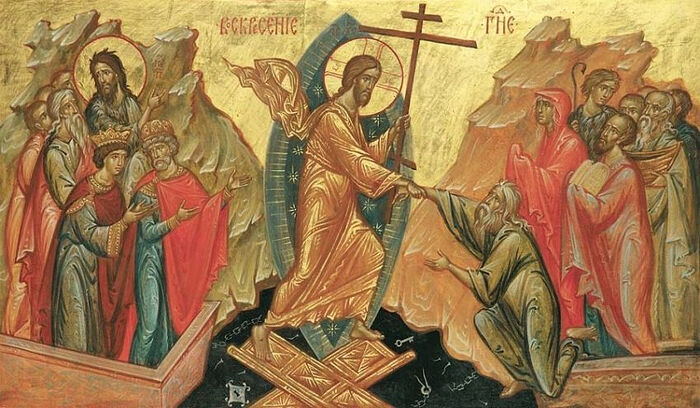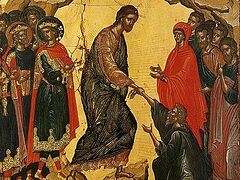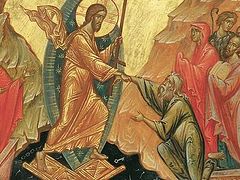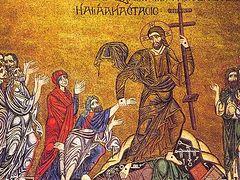The Apodosis (Leavetaking) of Pascha is celebrated on Wednesday of the sixth week after Pascha. On this day ends the forty-day celebration of the Bright Resurrection of Christ. For the last time we greet each other with the words of Paschal joy, “Christ is Risen!” and prepare ourselves to greet the upcoming feast of the Lord’s Ascension.
The Apodosis of Pascha. History
The last day of the afterfeast of great feasts such as Pascha, or of the Twelve Great Feasts, is called the “Apodosis”. These days have their own distinguishing liturgical features. From Church history we know that the leavetaking of the main Christian feasts, such as Pascha, the Nativity, and Pentecost, were honored as far back as the fourth century, and later their corresponding liturgical rubrics were accepted in the present form. The afterfeast of Pascha is of the longest duration as compared with all the other Twelve Great Feasts, lasting forty days; since according to Church Tradition, after His Resurrection from the dead, the Lord remained on earth during these days and appeared a number of times to His Mother Pure Mother and His holy disciples and apostles.
The appearances of the risen Jesus during the forty days after Pascha
The day of the leavetaking of Pascha was the last day in the life of Jesus Christ on earth, when the risen Lord appeared to His disciples in order to say His final words about the Kingdom of Heaven. We find the story of the appearances of the Risen Lord during the forty-day period from Pascha to the Ascension in all four gospels:
“According to St. John, Jesus first appeared to His disciples on the very day of the Resurrection, when the doors were closed; and then after the passing of eight days, when Thomas came to believe. Then, when they thought to go to Galilee and not all were gathered in one place, but certain of them were catching fish in the Sea of Tiberius, the Lord appeared only to the seven who were catching fish. What Matthew talks about took place later, after the event retold by John, for He often appeared to them throughout those forty days, now coming to them, now departing, but not present with them always and everywhere.”1
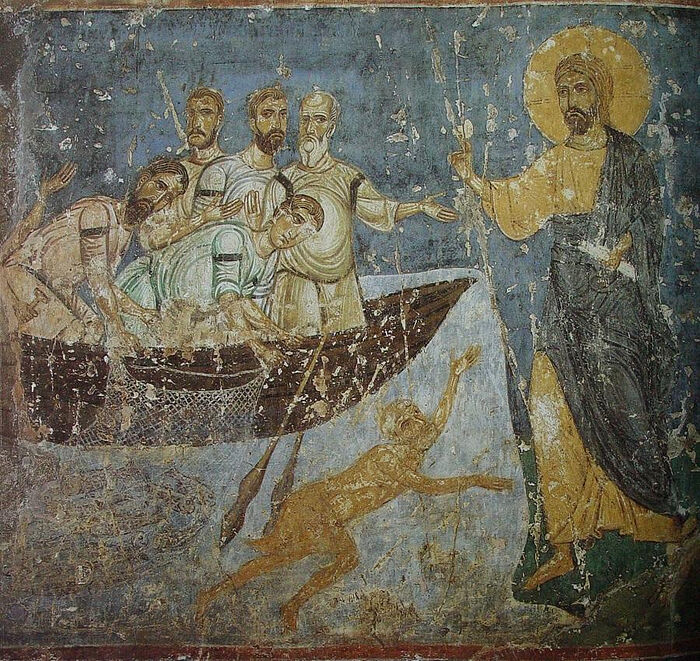 Christ’s appearance to the apostle on the Sea of Tiberius. Fresco, Cathedral of the Transfiguation, Mirozh Monastery, Pskov. 12th c.
Christ’s appearance to the apostle on the Sea of Tiberius. Fresco, Cathedral of the Transfiguation, Mirozh Monastery, Pskov. 12th c.
St. John the Theologian writes here in particular detail; the last part of the twenty-first chapter of the Gospel is dedicated entirely to a description of the Savior’s third appearance, which took place of the Sea of Tiberius. This time the Lord not only stood before the disciples, but also shared a meal with them; although after His Resurrection He no longer needed any physical sustenance, He ate so that they would be convinced, to show that He is risen in the very flesh in which He also suffered on the Cross. Then occurred one of the most remarkable events in the history of the newly-born Church of Christ, when Apostle Peter was entrusted with the care for the Church:
So when they had dined, Jesus saith to Simon Peter, Simon, son of Jonas, lovest thou me more than these? He saith unto him, Yea, Lord; thou knowest that I love thee. He saith unto him, Feed my lambs. He saith to him again the second time, Simon, son of Jonas, lovest thou me? He saith unto him, Yea, Lord; thou knowest that I love thee. He saith unto him, Feed my sheep. He saith unto him the third time, Simon, son of Jonas, lovest thou me? Peter was grieved because he said unto him the third time, Lovest thou me? And he said unto him, Lord, thou knowest all things; thou knowest that I love thee. Jesus saith unto him, Feed my sheep. Verily, verily, I say unto thee, When thou wast young, thou girdest thyself, and walkedst whither thou wouldest: but when thou shalt be old, thou shalt stretch forth thy hands, and another shall gird thee, and carry thee whither thou wouldest not. This spake he, signifying by what death he should glorify God. And when he had spoken this, he saith unto him, Follow me (Jn. 21:15–19).
“Because for Him the meal had an aim, He entrusts Peter with care for the sheep throughout whole world; He entrusts this care to none other than him, firstly because he was chosen out of all the others and was the voice of the entire host of apostles; and then in order to show that he must have boldness, for his denial has been forgiven. He does not mention the denial here, does not condemn him for it, but says, “If you love Me, then take care of the brethren and prove now that ardent love for Me concerning which you have said that you are ready to die for Me. He asks him three times, in part to show that He cares so much for the faithful and so loves His sheep that care for His sheep serves as a sign of love for Him; and in part that by a three-time questioning and confession He heals the three-time denial, and with words corrects the fall made by words.
“From this came the custom for those wishing to be baptized to confess [the faith] three times.
“After the first and second question, Peter calls Christ Himself as witness, Who knows the hearts; he no longer hopes in himself, no longer answers hastily, but each time adds, “You know”. When Peter was asked the third time, he was troubled—perhaps he mistakenly believes that he loves, when perhaps in fact he doesn’t love, because before he thought very highly of himself and his own strength. But what happened next proved him wrong. And now he is afraid of doing the same thing. Therefore he answers with reverence: “Lord! Thou knowest”, both the present and the future; You know that I now love You, as it seems to me; but whether my love will continue in the future, You know, and I don’t stand for myself. Having talked to Peter about love for Himself, the Lord foretells to him the torments he will endure. He does this in order to show that if He is asking him about love it is not out of mistrust, but because He is sure that Peter loves Him. For how could someone be tormented for someone he doesn’t love? He asks in order to more fully make Peter’s love known and to teach the others that if they desire to love Him, they must prove their love for Him by taking care of the brethren.
“By ‘lambs’ He means perhaps the neophytes, and by “sheep”, the more perfect. Thus, whoever loves Christ should take care of the lambs and the sheep; he should “feed” the lambs—that is, have a simpler watch over them; while the perfect have need of tender care, and those appointed to tend the sheep should feed them. “Shepherd” expresses a stricter tending, while “feed” is tenderer. What shall we render unto the Lord, Who has so loved us that as He has appointed care for His sheep as a sign of love for Him?2
The next appearance of the Risen Lord, according to the explanation of Blessed Theophylact of Ohrid, is described in the gospel of Evangelist Matthew, when He commanded His eleven apostles to gather in Galilee and instructed them to go forth and preach to the whole world. Here the Savior makes His triumphant promise to be with the Christian race inseparably: And lo, I am with you always, even unto the end of the world. Amen (Mt 28:20).
“Encouraging His disciples (as He was sending them to pagans, to the slaughter and danger), He says, “Fear not, for I will be with you to the end of the world. Look also at this, at how he reminded them of the end, in order to arouse in them an ever greater disdain for danger. Fear not, He says; there is an end to everything, be it worldly woes or prosperity. Therefore do not fall away when woes come, for they will pass; neither be deceived by goodly things, for they will end. Moreover this applies not only to the apostles, that He will be only with them, but to all His disciples; for obviously the disciples would not live to the end of the world. Thus this is promised also to us, and to those after us. However it doesn’t mean that He will be with us to the end, but leave after the end. No! Then He will especially be with us, and in the clearest and most obvious way at that; for whenever used in Scripture, the word “until” does not exclude what comes afterwards.”3
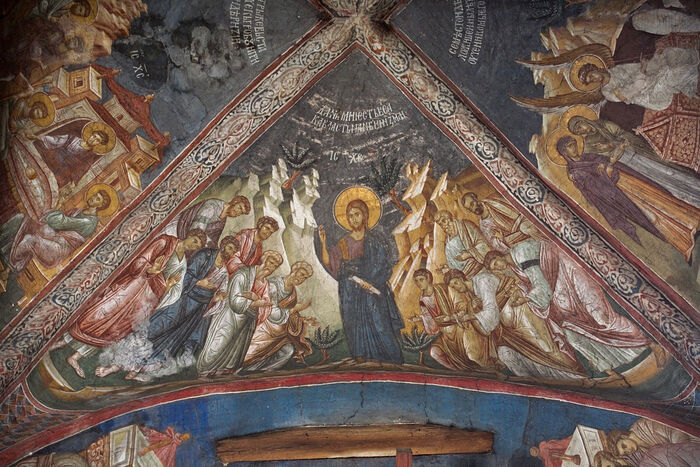 Christ’s appearance to the apostles on mountain of Galilee. Decani Monastery, Serbia. 14th c.
Christ’s appearance to the apostles on mountain of Galilee. Decani Monastery, Serbia. 14th c.
The evangelists Mark and Luke retell the final conversation with the disciples, before the Ascension itself, with the Savior’s parting words and commandments to the apostles:
And he said unto them, Go ye into all the world, and preach the gospel to every creature. He that believeth and is baptized shall be saved; but he that believeth not shall be damned. And these signs shall follow them that believe; In my name shall they cast out devils; they shall speak with new tongues; They shall take up serpents; and if they drink any deadly thing, it shall not hurt them; they shall lay hands on the sick, and they shall recover. So then after the Lord had spoken unto them, he was received up into heaven, and sat on the right hand of God. And they went forth, and preached every where, the Lord working with them, and confirming the word with signs following. Amen (Mk 16:15–20).
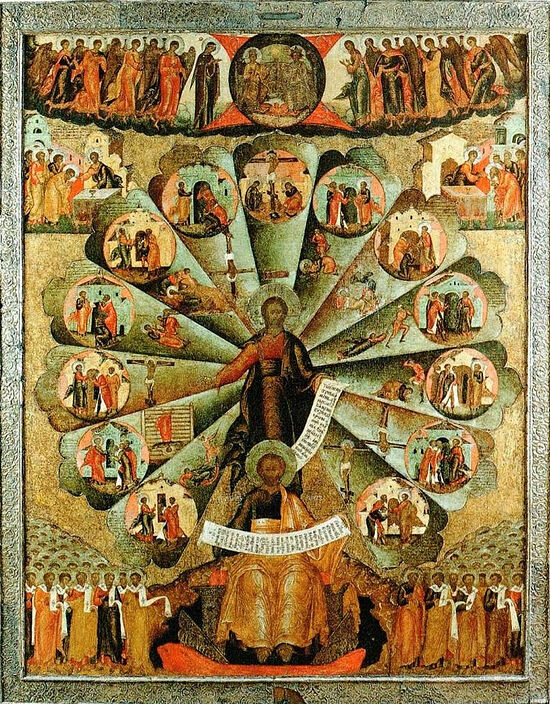 Apostolic preaching. C 1668, Veliki Ustiug.
Apostolic preaching. C 1668, Veliki Ustiug.
“Note the Lord’s commandment: Preach to every creature. He did not say, “only to the obedient”, but to all creatures, whether they heed it or not. Believing is not enough; those who believe must also be baptized. For whoever has believed but was not baptized, remaining a catechumen, will not yet be saved. The believing will be accompanied by signs: the casting out of demons, speaking in new tongues, and the destruction of serpents both tangible and mental, as it was said in another place: Behold, I give unto you power to tread on serpents and scorpions (Lk. 10:19)—obviously, mental. The expression, “taking up serpents” may also be meant literally. Thus for example the apostle Paul took a snake into his hands without being harmed at all (cf. Acts 28:3–5). And if they drink anything deadly it will not harm them. This has happened many times, as we find in various narrations—for many drank poison but remained unharmed through the power of the sign of the cross. After His talk with them, the Lord ascended into heaven and sat at the right hand of God. And they went and preached everywhere, with the Lord’s cooperation also giving strength to their words with signs following… Do you see? Everywhere we have first our own action, and then God’s cooperation. For God cooperates with us when we act and place a beginning; but when we do not act, He does not work together with us. Note also that after words follow deeds, and the word is confirmed by deeds. So it was with the apostles, when their words were confirmed by the actions and signs that followed. O Christ the Word! If only our own words about the virtues would be confirmed by deeds and actions, so that we would appear perfect before You, Who works along with us in all our deeds and words! For to You is due glory in both our words and deeds. Amen.”4
The Apodosis of Pascha. Liturgics
The church services for the Apodosis of Pascha are celebrated with particular solemnity. On this day are joined three services of the typicon: the feast of Pascha, the Sunday of the Blind Man, and the Forefeast of the Lord’s Ascension. The third, sixth, and ninth hours, as well as the antiphons at the Liturgy, are sung according to the Paschal services. It is a fast day, but in the Triodion there is a special recommendation that “at the trapeza there be consolation for the brethren”: “We take oil, fish, and wine, giving thanks to God.” Thus do the faithful take leave of the Paschal hymns until next year, and return (except for the prayer “O Heavenly King”) to the ordinary yearly rubrics for prayers.
Church hymnody appointed for this period speaks mostly about one and the same thing. “Shine, shine O new Jerusalem, for the glory of the Lord is risen upon thee. Now dance for joy and be glad O Sion. And thou, Pure Mother of God, rejoice in the rising of thy Son”—the post-Paschal “zadostoinik” (in place of the hymn, “It is truly meet”) written by St. John Damascene, which we read everyday in church and home prayers, always raises us up mentally to the new world and the Heavenly Jerusalem. St. Nicodemos the Hagiorite in his explanation of the Paschal canon explores in detail the spiritual meaning of this commonly known, exalted prayer:
“The God-inspired singer heard the Prophet Isaiah say, ‘Draw water from the wellspring of salvation’ (Is. 12:3) (by the ‘wellspring of salvation’ is meant Divine Scripture, according to explanations); therefore he himself to this day drew many thoughts from Divine Scripture and watered spiritual gardens with them by his canon odes, and yet draws sayings from the same prophet, saying, Arise, shine; for thy light is come, and the glory of the Lord is risen upon thee (Is. 60:1) and turns this into the present irmos, slightly changing it and saying: “O new Jerusalem, the catholic Church of Christ, shine, shine.” The poet repeats this word twice, firstly to confirm the illumination, and secondly from the over-abundance of joy. For it is the custom for those confirming some deed as well as of those greatly rejoicing to repeat the same word twice, as the great Gregory said: ‘Renewal, renewal is our feat, brothers; let this be repeated more than once in our delight!” (Homily on Renewal Week). Thus, shine! Because the glory of the Lord has shone upon you; and the glory of the Lord, according to Theodore, is the Cross of Christ—for Scripture says: Now is the Son of man glorified (Jn 13:31). But, in the words of St. Gregory the Theologian, it is the divinity of Christ that Paul also confirms: the Father of glory (Eph. 1:17); that is, the Divinty, or in other words, the glory of the Lord—divine light and the radiance of His countenance, as it is said: The glory of the Lord shone round about them (that is, the shepherds) (Lk. 2:9), for these three have shone upon you, O Church of the gentiles.
“So that it might become clear that the Jews seeing do not see, according to the prophecy of Isaiah, and the people sitting in darkness (that is, the gentiles), have seen the great light of the knowledge of God, for amidst those very Jews Christ the Sun of Righteousness was hidden because of their unbelief; because having been put to death by them, He hid Himself and reigned in the depths of the grave and hell, and has shone amongst us, those of the gentiles who believed, because we recognized the rising of His Divinity and were illumined with the light of piety and virtue. The singer enjoins also the new Sion to dance spiritually and be glad in the Resurrection of Christ the Bridegroom, because Christ’s joy and exaltation is also ours. Then he turns his words to the Theotokos—not in vain or in passing, but with the aim of showing that this irmos belongs to the ninth ode, the hymnographer of which is the initiator and composer, Our Lady Theotokos. And therefore he says to her: “And thou O Mother of God, exalt and rejoice in the Resurrection of thy Son. For before, a sword of sorrow pierced thy heart from the suffering and death of thy Son, according to Simeon’s prophecy. So now also is it just for thee to rejoice and be glad first, more than all others, for the Resurrection of thy Son, as thou didst prophecy in thy song, saying, My spirit hath rejoiced in God my Savior (Lk. 1:47).”

